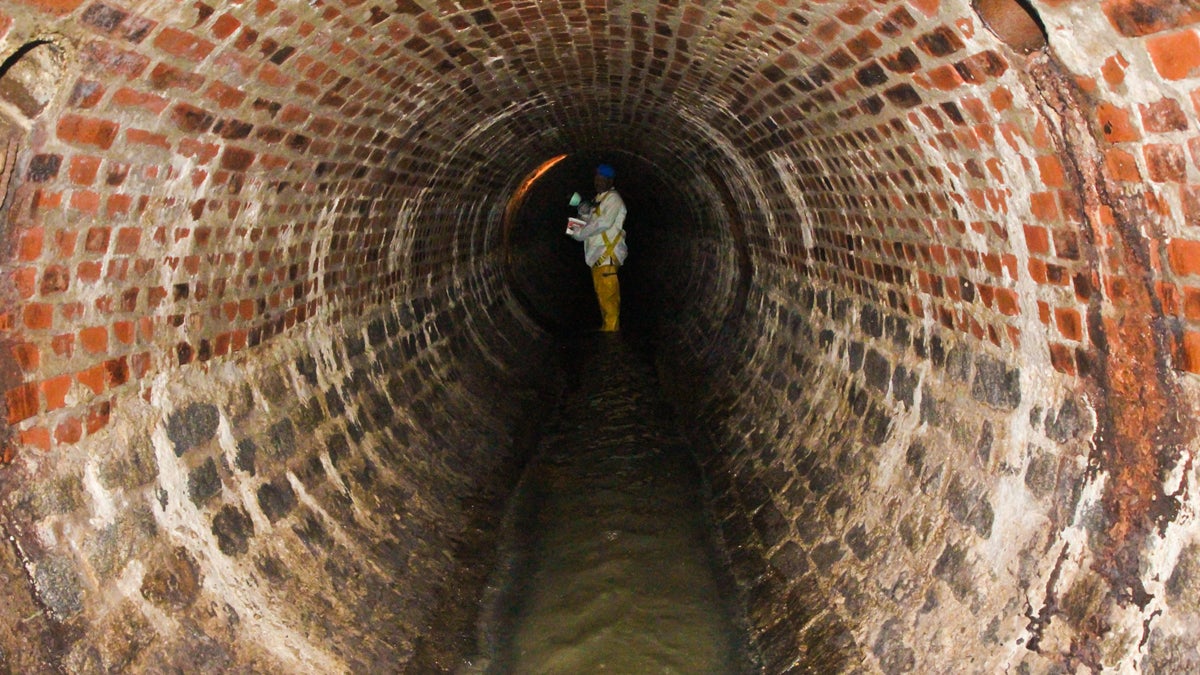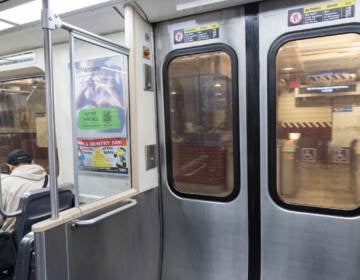The state of sewer pipelines in Pennsylvania

Wastewater pipeline infrastructure in Pennsylvania is old and in some cities pollutes rivers. In Philadelphia about half of the wastewater system has brick piping. John Key Junior inspects a sewer in Philadelphia, Pa. (Kimberly Paynter/WHYY)
Wastewater pipeline infrastructure in Pennsylvania is old and in some cities pollutes rivers.
Pennsylvania is an old state, one where people settled and built infrastructure early. That means much of the infrastructure in the Commonwealth’s cities is breaking down with age, needs expensive maintenance, retrofits, or replacement, or just doesn’t fit with contemporary ideas of urban planning. Add to that many cities’ struggling budgets, which keep sewer repairs and maintenance from being addressed in a timely manner.
Keystone Crossroads previously covered where bridges and roads stand, but what about sewers?
What condition are pipes in?
The short answer is it’s hard to say.
A pipe’s lifetime can range from 15 to 100 years depending on what material was used to build it and the soil it sits in, according to the American Society of Civil Engineers (ASCE). For example, about half of Philadelphia’s wastewater system has brick piping, which tends to be pretty resilient. In Pennsylvania, some of the oldest pipes came online in the 1800s and have been operating for close to 200 years.
But according to the ASCE, “there is no requirement for sewer systems to inspect and assess the condition of their pipes and to be able to quantify the total length of pipes that are [in] need of rehabilitation.” There’s also “no exact standard to identify a system as in need of rehabilitation,” said Pennsylvania Department of Environmental Protection’s (DEP) Amanda Witman. That makes it hard to say definitively how many miles of pipeline are in what condition.
Pennsylvania’s Act 537, the Sewage Facilities Act, does require sewage systems to have management plans and these have to track how much liquid gets into the pipes from the ground, which would suggest cracked or broken pipes. The plans have to be updated when new development happens or a municipality’s sewer system needs change, like if the population grows. In many municipalities the plans are older than 40 years.
Cracked or broken pipes aren’t the only problem, though. Some sewage systems were designed in a way that doesn’t meet today’s environmental regulations; combined sewers are a common example.
What is a combined sewer overflow (CSO) system?
Combined sewer systems collect sewage, rain and melted snow (or runoff), and industrial wastewater into one pipe. The pipe carries all of that to a wastewater treatment facility where it is cleaned and eventually discharged back into a river or other water body. Heavy rains or snowmelt can overwhelm the system, and when pipes exceed the capacity of the sewage treatment plant, the flow — sewage and all — gets discharged into a nearby stream.
Many older communities in the Northeast and Midwest have CSOs. This type of system emerged when city planners primarily thought of waterways as industrial, utilitarian assets. Today, cities increasingly see their rivers as recreational assets, as well, with diverse ecosystems to maintain.
An alternative system emerged after World War II. In a separate sewer system sewage runs in one pipe and any storm runoff flows in a parallel, but separate pipe. That way, when there’s a big storm, only runoff enters the streams and rivers through the outflows, a pipe terminus that lets out into a stream. (Even with a separate sewer system, sewage overflows can happen when pipes are cracked and receive inflow during a storm or are somehow improperly blocked.)
How do Pennsylvania’s CSOs compare with other states?
According to the ASCE, “Pennsylvania has the most combined sewer overflows (CSOs) of any state.”
Pennsylvania has 1,608 combined sewer outfalls in 39 counties; that’ about 17 percent of all such outfalls in the United States, though it’s important to note Pennsylvania is a large, populous state with extensive infrastructure.
Why are combined sewer overflows a problem?
CSOs sometimes dump untreated sewage into waterways — some of which are used for recreation and/or as a source of drinking water — and pollute them. According to the Environmental Protection Agency (EPA), “CSOs have contributed to beach closures, shellfish bed closures, contamination of drinking water supplies, and other environmental and public health concerns.”
What are cities doing to fix these problems?
At the federal and state levels, the goal is to eliminate CSOs entirely. Under the Clean Water Act, the EPA requires municipalities to put together long term plans to manage storm water in a way that will ensure streams meet water quality standards. Many communities have plans in place to eventually separate their CSOs or reduce flows during storm events. Some of the plans are the result of consent decrees — legal settlements that agree on specific action without the defendant admitting fault — with the EPA and/or the DEP.
Federal and state money is available for these pricey infrastructure projects: since 1988, PennVEST has approved $7.78 billion in loans and grants for nearly 3,000 projects throughout the state, including $131 million for water and wastewater projects approved this April.
Here are just some examples of what cities are doing:
Philadelphia, in addition to maintaining its existing system, adopted a 25 year Green City, Clean Waters plan, which outlines ways the city can use green infrastructure to mimic natural processes and divert runoff from entering pipelines.
Erie has reduced its CSO outflows from 45 to 5.
In Pittsburgh, the Allegheny County Sanitary Authority (ALCOSAN) has been under consent decree since 2007 with the EPA and the DEP to change the sewage system to better meet Clean Water Act standards. Ultimately, ALCOSAN will have to divert some water from entering the system in the first place, as well as add infrastructure to treat more of the waste and storm water that enters the pipelines during storms.
Johnstown has structural defects throughout its wastewater collection system and has entered a consent order with the DEP to decrease the amount of waste being dumped into the city’s rivers.
Scranton has made improvement to its system after the EPA and DEP filed complaints against its frequent discharges or raw sewage into streams.
Harrisburg also settled with the EPA and DEP and the city’s Capital Region Water will spend more than $80 million to reduce sewage dumps into the Susquehanna River.
In all, according to the EPA’s 2008 Clean Watersheds Needs Survey (it’s the latest available), Pennsylvania needs nearly $18 billion of investment for sewer infrastructure. The largest chunk of that, nearly $9 billion, is to address CSOs. That only covers problems that needed to be addressed as of 2008, and not the additional issues that are sure to add up in aging systems.
WHYY is your source for fact-based, in-depth journalism and information. As a nonprofit organization, we rely on financial support from readers like you. Please give today.





